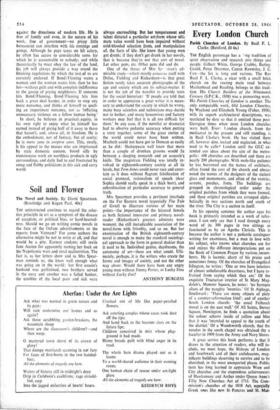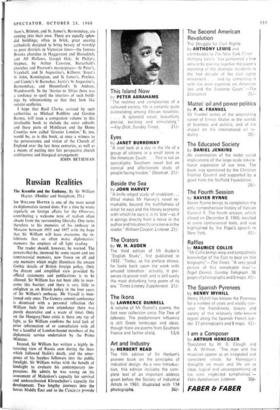Every London Church
THE English parsonage has a '-mg tradition of quiet observation and research into things and people. Gilbert White, George Crabbe, Baring- Gould, Percy Dearmer, Canon Rawnsley, J. C. Cox—the list is long and various. The Rev Basil F. L. Clarke, a vicar with a small brick church on the roaring main road between Maidenhead and Reading, belongs to this tradi- tion. His Church Builders of the Nineteenth Century (S.P.C.K., 1938) was a pioneering work. His Parish Churches of London is another. The only comparable work, Old London Churches, by Wayland and Elizabeth Young (Faber, 1956), with its superb architectural descriptions, was restricted by date so that it omitted those post- Georgian times when most London churches were built. Ever, London church, from the mediaeval to the present and still standing, is in Basil Clarke's book. He has visited them all, however dim, locked and neglected, in what used to be calk,' London until the GLC ex- tended our ideas about the size of the metro- polis: 498 churches are described and there are nearly 200 photographs. With mole-like patience he has burrowed out the names of architects, often found the cost of the church and always noted the names of the designers of the stained glass and monuments, and often of the vestries, screens, porches, fonts. The buildings are grouped in chronological order under the original parishes from which they were formed, and these original parishes are arranged alpha- betically in two sections north and south of the river. The City is a section to itself.
In his opening sentence the author says his book is primarily intended as a work of refer- ence. I can only say that I read through every word of its 300 pages in two sittings as fascinated as by an Agatha Christie. This is because the author is not a pedantic cataloguer writing for examinees, but a man in love with his subject, who knows what churches are for and enjoys the different interpretations put on the Book of Common Prayer by various incum- bents. He is laconic, chary of his praise and sometimes funny. Of the churches of Evangelical Islington, he writes: 'One or two have interiors of almost unbelievable dreariness, but I have re- frained from saying which they are.' Of the exquisite Tractarian interior of St Mary Mag- dalen's, Munster Square, he notes: 'no baroque altars of the naughty 'twenties.' Of St Alphage, Southwark : 'There are many objects of piety of a counter-reformation kind'; and of another South London church: 'the usual Feibusch mural is on the east wall.' Of All Saints, Surrey Square, Newington, he finds a quotation about the colour scheme inside of yellow and blue that it was intended to appeal to the youth of the district.' Of a WandswOrth church, that the reredos in the south chapel was obtained (by a faculty) in 1909 from the Army and Navy Stores.
A great service this book performs is that it draws to the attention of readers, who will in- clude, we must hope, the Bishops of London and Southwark and all their archdeacons, mag- nificent buildings deserving to survive and to be cherished, in the most unexpected places. Public taste has long learned to appreciate Wren and City churches and the stupendous achievements of Hawksmoor and Archer under Queen Anne's Fifty New Churches Act of 171.1. The Com- mission's churches of the 1818 Act, especially Greek ones like new St-Pancras and St. Mat-
thew's, Brixton, and St. James's, Bermondsey, are coming into their own. There are equally splen- did buildings, often in brick, great soaring cathedrals designed to bring beauty of worship to poor districts in Victorian times—the famous Brooks churches in Haggerston and Shoreditch, and All Hallows, Gospel Oak; St Philip's, Stepney, by Arthur Cawston, Butterfield's churches and Pearson's masterpieces—St Peter's. Vauxhall, and St Augustine's, Kilburn; Street's St John, Kennington, and St James's, Pimlico, and Cundy's St Barnabas; Jarvis's St Augustine's, Bermondsey, and Mountford's St Andrew, Wandsworth. In the 'thirties to 'fifties there was a tendency to spoil the interiors of such build- ings by whitewashing so that they look like outsize sculleries.
I hope that Basil Clarke, assisted by such authorities as Michael Robbins and Gordon Barnes, will issue a companion volume to this invaluable book to include the outer suburbs and those parts of Middlesex and the Home Counties now called `Greater London.' It, too, would be, as is this book, at once a witness to the perseverance and vision of the Church of England over the last three centuries, as well as a means of putting into fair perspective church architecture and liturgical arrangement.
JOHN BETJEM AN







































 Previous page
Previous page